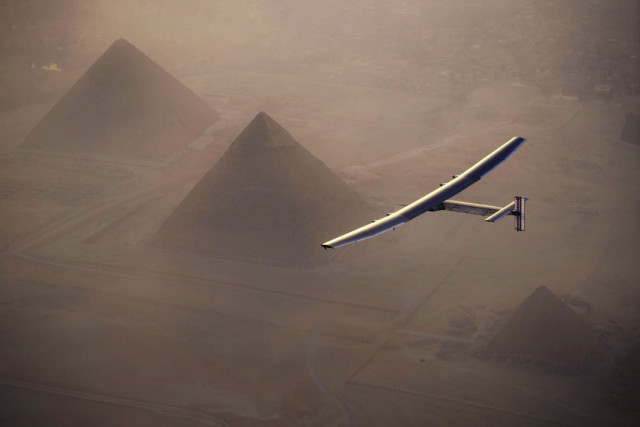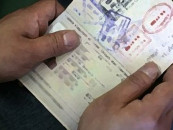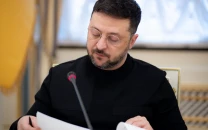Solar plane lands in Egypt in penultimate stop of world tour
After the two-day flight from Spain, just one final leg lies between it and its final destination, Abu Dhabi

Solar Impulse 2, the solar powered plane, piloted by Swiss pioneer Andr Borschberg, is seen during the flyover of the pyramids of Giza on July 13, 2016 prior to landing in Cairo, Egypt. PHOTO: AFP
After the two-day flight from Spain, just one final leg lies between it and its final destination, Abu Dhabi, where it started its odyssey in March last year.
Solar Impulse 2 lands in Spain after 70-hour transatlantic flight
The aircraft landed in Spain last month, after completing the first solo transatlantic flight powered only by sunlight.
After setting off from Seville on Monday morning, the plane passed through Algerian, Tunisian, Italian and Greek airspace, and flew over the Giza Pyramids before touching down at Cairo airport at around 7:10 am (0510 GMT).
Its support crew cheered as the plane, no heavier than a car but with the wingspan of a Boeing 747, landed, and trailed after it on bicycles.
"It was fantastic, everything worked well," pilot Andre Borschberg told the control tower, as a live stream from the cockpit was broadcast on Solar Impulse 2's Facebook page.
He emerged from the cockpit and hugged Bertrand Piccard, with whom he has taken turns flying the plane around the world.
Solar Impulse 2 begins Atlantic crossing
Solar Impulse is being flown on its 35,400-kilometre (22,000 mile) trip round the world in stages, with Piccard and his Swiss compatriot Borschberg alternating at the controls of the single-seat plane.
Picard, who had arrived early to greet the plane, told reporters that flying Solar Impulse 2 showed what new technologies can do.
The 58-year-old had flown the plane across the Atlantic in a 6,765 kilometre (4,200 mile) journey.
It had completed its flight from New York to Seville in 71 hours, flying through the night with the energy stored in its 17,000 photovoltaic cells.
"It's a new era for energy," he said.
"I love to fly this plane because when you are in the air for several days you have the impression to be in a film of science fiction," he said.
"You look at the sun, you look at your motors, they turn for days and for days, no fuel. And you think that's a miracle. That's magic. It is actually the reality of today. This is what we can do with these new technologies."
He said the pilot takes 20 minute naps during the long flights, as the plane inches across the sky at about 48 kilometres (36 miles) an hour.
Borschberg had piloted the plane in its 8,924 kilometre (5,545 mile) flight from Japan to Hawaii in 118 hours, breaking the previous record for the longest uninterrupted journey in aviation history.
"It is comfortable. But of course you need to train for that. You need to train to make some exercise in the capsule, in the cockpit, because otherwise after several days you cannot move your legs and your arms anymore," Piccard said.
Solar Impulse 2 leaves New York, begins Atlantic crossing
Borschberg and Piccard have said they want to raise awareness of renewable energy sources and technologies with their project.
But Piccard does not expect solar powered commercial planes any time soon.
"There will not be passengers very soon in solar airplanes like ours," he said.
"But there will be passengers very soon in electric airplanes that we will charge on the ground," he predicted.
"On the ground you can charge batteries and you can have short haul flights maybe 500 kilometres (310 miles) with 50 people flying in these planes" in a decade, he said.


















COMMENTS
Comments are moderated and generally will be posted if they are on-topic and not abusive.
For more information, please see our Comments FAQ